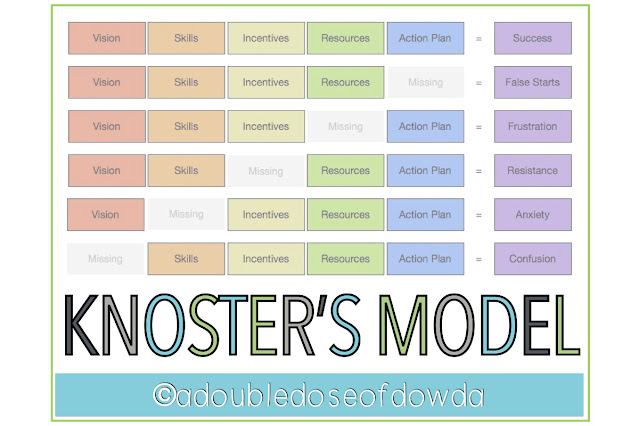Knoster’s Model for Managing Complex Change is a great strategy for instructional coaches.
As coaches, we help teachers to make changes and change can be difficult.I keep Knoster’s Model in mind when working with teachers to help ensure lasting change.
What to look for in this post:
- An overview of Knoster’s Model for Managing Complex Change
- Using Knoster’s Model as an instructional coach
[0:18] An overview of Knoster’s Model for Managing Complex Change
For there to be successful change, people have to be clear on the vision. They have to know what is expected and why a change needs to be made. Resources have to be available for success, and they have to have the skills and the motivation to change. A clear action plan will help them to make changes step by step.What I love about the above table is it shows you exactly what result you can expect if a specific piece is missing.
[1:06] Using Knoster’s Model as an instructional coach
In a best-case scenario, you might only be missing one thing from the table. When I am doing coaching work with teachers, I have to make sure that they are clear on the overall vision for the direction we are headed. In addition, I need to ensure that they have the skills required to make that change. Finally, I need them to have incentives and to feel motivation to change.As an instructional coach, it is my job to provide teachers with the resources they need in order to make changes. I make a clear action plan with them so that we can ultimately see success.
Check out these related posts:
Coaching Teachers on Behavior Management Strategies for the Classroom
Types of Feedback for Instructional Coaching: Bless
Types of Feedback for Instructional Coaching: Address
Types of Feedback for Instructional Coaching: Press
Instructional Coaching in 5 Words
4 Tips for a New Instructional Coach
Check out these related YouTube videos:
When Teachers Need Help with Behavior Management
Coaching Feedback for Teachers: Part 1: Bless
Coaching Feedback for Teachers: Part 2: Address
Coaching Feedback for Teachers: Part 3: Press



No comments
Post a Comment